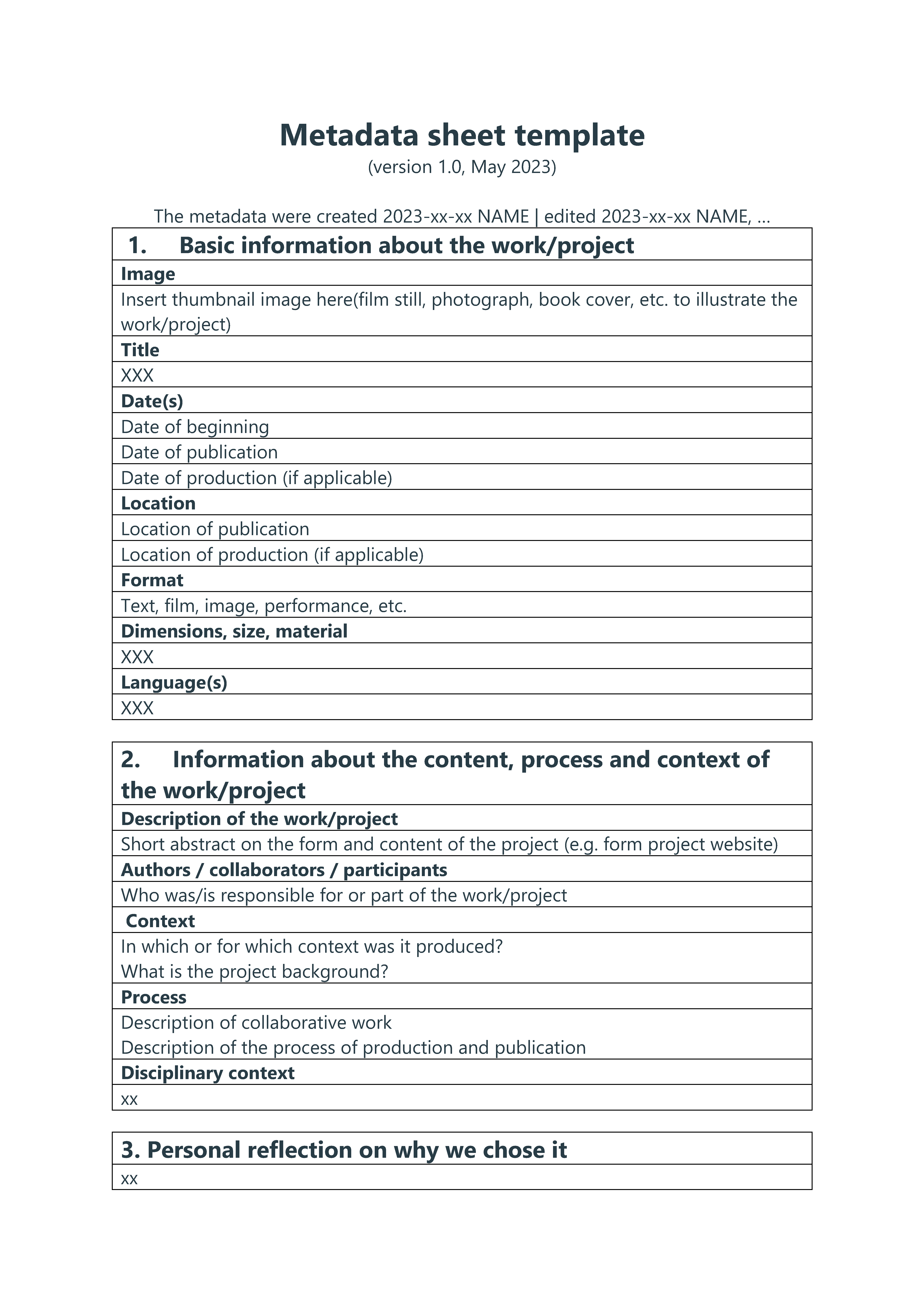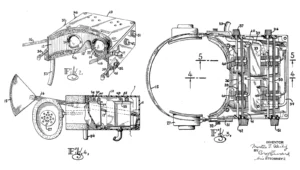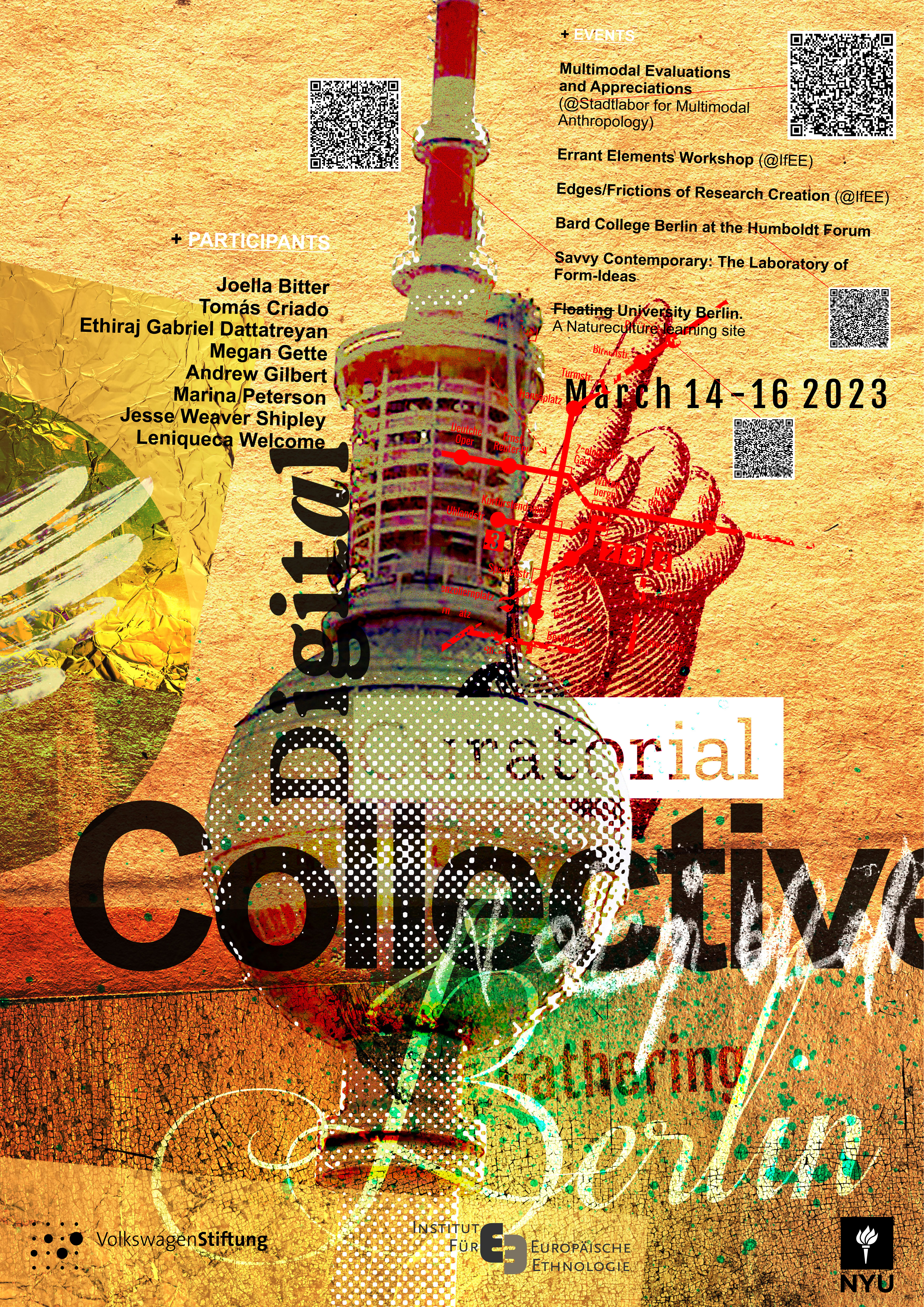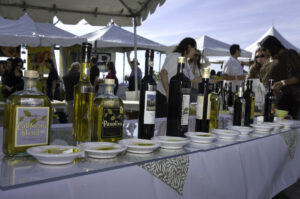In this post, we include a collective reflection on creating the metadata sheet we are using to inventory multimodal works. These reflections are divided according to each category or heading in our metadata sheet, whose first version (from June 2023) you could downloawd here.
In the process of creating this template, it became clear both how complex such a task is as well as all obstacles to documenting the relevant elements that constitute what a multimodal work is or can be.
metadata sheet template
The meta data were
created 2023-03-xx NAME
edited 2023-03-xx NAME
Reflection
Traceability and version control matter to preserve the intrinsic multi-vocality of our project’s team. Who created or modified something might not be more relevant than having had the time to do things; indeed, it might simply reflect that someone was free at that time or a pre-determined division of labour. And understanding who changed things might enable the chance to reverse changes. Additionally, this also makes visible the labour of individual team members, which is a form of tacit acknowledgement of a member’s contribution. And finally, traceability also makes visible distinct disciplinary and sub-disciplinary approaches, allowing us to identify the interdisciplinary work of the project. So it is not only polyphony but also disciplinarity that can be traced. What influences the inclusion of a work? Which impulse led to which decisions of inclusion or exclusion?
1. Basic information about the work/project
Image
Thumbnail (film still, photograph, book cover, etc. to illustrate the work/project)
INSERT IMAGE HERE
Title
xxx
Date(s)
Date of beginning
Date of publication
Date of production (if applicable)
Reflection
Multimodal projects tend to take quite an amount of time. Of course, documenting beginnings and endings is not all that there is. Most of the times, these projects/works have strange temporalities, which we would like to trace: process is punctuated by different products or iterations, there are interruptions and things happening at the same time, like in a whirlwind. We wish to use dates of beginning, production and publication as indexes of these complex processes. Moreover, we have noted that much of the value of a multimodal project is related to the research or production process rather than the main artefact at the end (for example, think of the House of Gossip project and how much of its value is lost if one only looks at the board game artefact). Documenting starts and conclusions can point to these processes, and at least allow us to ask questions about them.
Location
Location of publication
Location of production (if applicable)
Reflection
This category is the natural companion of its predecessor, for documenting geographies also points us to documenting temporalities. Multimodal projects are sometimes place or site-specific, but at other times their production or reflection happens in dislocated places, with people at a distance. For example, some projects happen in one place and are discussed or published in another, or simultaneously happening in different places. To have a sense of these complex geographies of multimodal production this category wants to provide an overview of relevant places and spaces. This category also raises the question of which publics can be reached. For example, it appears that most multimoral works exist in one or two languages and very rarely are there more than bilingual productions. This means that the places of production, the places of publication, and the languages in which the collaboration took place need to be thought together. For example, if a project was a transnational work, which participants and which public can access projects results (even if they are digital) if those results end up only being in English? Thus these categories in the metadata sheet point to existing power relations that need to be identified and critically approached.
Format
Text, film, image, performance, etc.
Dimensions, size, material
Reflection
“But what do you mean by multimodal or more-than textual?” We’ve all heard that question several times. Interestingly, most of our responses tend to devote a lot of time to discuss issues of format: how something was produced, what the affordances or exclusions are contained in a media form, etc. What’s clear is that any reflection on these processes or products requires us to talk about their materiality, their feel – also, since we plan to ‘situate ourselves in presence of these works’ (whether travelling or bring it to our bodily presence), having a sense of their composition, volume and potential fragility are relevant questions to discuss how feasible this might be. Certain materialities come with their own discourses and are in themselves a world of associations. Why we choose a particular format or material often has to do with an in-depth engagement with a context and how we want to make research content and experience comprehensible. So whether an artefact is digital or analogue, paper or stone, water, air, a record or CD, also influences where and how it can be presented, how it can be located disciplinarily or interdisciplinarily, etc.
Language(s)
Reflection
One might think that since it’s more-than-textual, language doesn’t matter, right? Well, we disagree: the languages of production matter a great deal. We might think of language as an affordance, and the existence of multiple languages or at least lexical items from diverse language families as offering insights to its potentials. Going beyond the textures and genres of languages employed (in a more semiotic sense), this category also aims to make us aware of the linguistic realms that multimodal projects inhabit. Put simply, “what language they are in” indexes the geographies and practices by which they were produced, where they can more easily travel, etc. Thinking about language also indicates the importance translation plays within a project. Expanding on a reflection we made above, this tells us a lot about questions of accessibility, about (intended) audiences and publics, and about participants. It can reveal the limits and possibilities of connection. Dealing with language and struggling with translatability may be a impulse for working with more-then-text because it sensitizes and trains us to look for other tools (images, body language, etc.).
2. Information about the content, process and context of the work/project
Description of the work/project
Short abstract on the form and content of the project (e.g. form project website)
Authors / collaborators / participants
Who was/is responsible for or part of the work/project
Context
In which or for which context was it produced?
What is the project background?
Process
Description of collaborative work
Description of the process of production and publication
Reflection
Learning to appreciate what a multimodal project is cannot be done by simply paying attention to the final product (or even to different versions). Attuning our senses to and our interests in these projects requires understanding their features and their processes, as well as their conditions of production, legibility and circulation. Hence, these categories have the main purpose of allowing us to have a sense of how the project came to be, who was involved and the relevant division of labour for their production, as well as the concrete approaches to collaboration, not to mention the demands or interests that might have originated it. Put another way, convention defines anthropology as a contextual science and these categories allow us to begin to get a sense of which contexts might matter when it come to understanding what a multimodal project is, and what it does. To understand these contextual elements, we start by staying as close as we can to the very self-descriptions given by the producers. But we also create a space where we can experiment with categories of description we might use independently of the self-presentation of a work.
Disciplinary context
xxx
ReflectionEven if several strands of more than textual ethnographic work might be indistinguishable from productions in other fields (installations, films, etc.) we wish to acknowledge the peculiar strands of anthropological and other kinds of disciplinary works the project wishes to be in dialogue with – this matters to understand how the producers situate their relevance, and might also matter to learn to appreciate the ways in which they could dialogue with the conventions and inventions of a peculiar field or sub-domain
3. Personal reflection
Reflection
A section where we make visible the ways in which this project, rather than attempting (in vain) to work from a comprehensive catalogue of multimodal works, instead proceeds from the individual interests and biographies of team members. It is an open acknowledgement of ways in which this project and what comes of it proceeds from this partial and particular basis (which all such project much do). It also is a way for us to learn from one another, and about one another.



